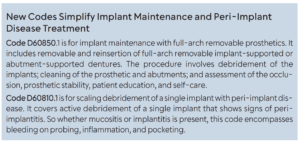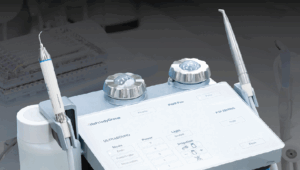ADA CDT Updates Improve Implant Maintenance Documentation and Care
These new codes are making it easier for clinicians to accurately diagnose and bill for nonsurgical implant maintenance procedures.
Two new American Dental Association (ADA) Current Dental Terminology (CDT) codes — D60850.1 and D60810.1 — are making it easier to document and bill for implant maintenance procedures.
Prior to the introduction of D60850.1 and D60810.1, most dental practices used codes that didn’t adequately reflect the complexity or time involved in implant maintenance. When disease is present, this often results in under-documentation, inaccurate billing, and challenges in distinguishing preventive care from disease management for implants.
These new codes allow for more accurate documentation and diagnosis-driven care, which leads to better reimbursement for the practice. Clinicians often face the challenge of balancing patient care with the constraints of insurance requirements, while also helping patients understand what their coverage includes. We never want patients to think a treatment isn’t valid if insurance doesn’t cover it.
These codes help categorize patient needs, creating alignment between the patient, clinician, front office team, and insurance provider. Dental hygienists can now differentiate between routine maintenance, complex prosthetic management, and peri-implantitis care and the patient is better informed about the procedure.
Implants are an investment for patients and they need help in supporting their long-term health and longevity. This equates to a growing need for dental hygienists who are well-trained on implant-specific protocols.
As such, we need to be up-to-date on the latest treatment strategies, such as air polishing for biofilm maintenance with implants. Air polishing technology has raised the bar for implant maintenance and we should embrace it. These new codes support the use of devices such as HuFriedy Group’s PWR Pair, which provides the power of sub- and supragingival calculus and stain removal, biofilm disruption, and implant cleaning. It uses glycine powder, which is gentle and minimally invasive.
The PWR Pair enables debridement of the implant surface effectively without damaging the titanium. Now dental hygienists can be confident they are removing biofilm and accessing tighter areas without damaging the peri-implant mucosal seal.
The new codes will support the clinical team in identifying and addressing implant maintenance earlier. More specificity in codes encourages providers to schedule appropriate intervals for care, improve communication about risks, and justify individualized treatment plans. Dental hygienists need to validate the care they provide and communicate its importance to patients. In turn, patients will experience better implant longevity, fewer complications, and an improved quality of life.
HUFRIEDY GROUP
hufriedygroup.com/en/pwr-pair
800-483-7433
From Dimensions of Dental Hygiene. September/October 2025; 23(5):22.



